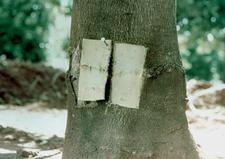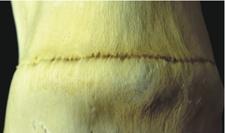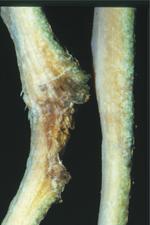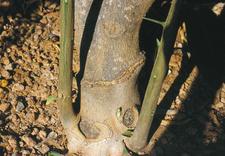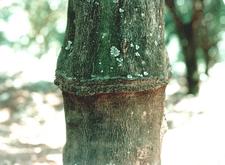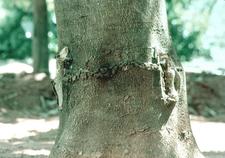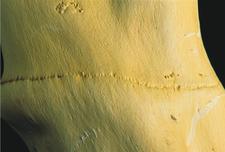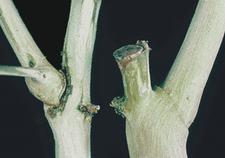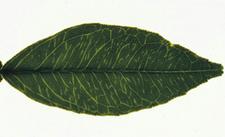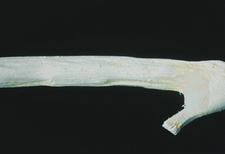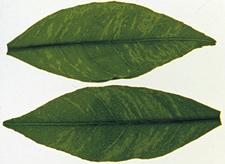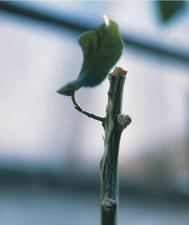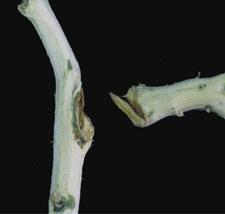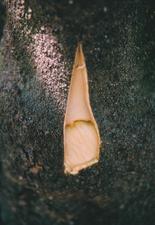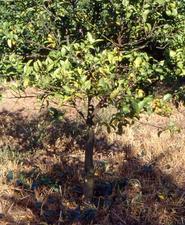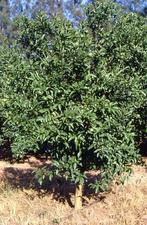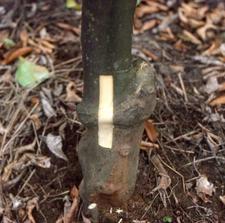- Text - Bud Union Disorder of Sweet Orange on Rough Lemon
- Images - Bud Union Disorder of Sweet Orange on Rough Lemon
- Text - Bud Union Disorder of Nagami Kumquat on Trifoliate Rootstocks
- Images - Bud Union Disorder of Nagami Kumquat on Trifoliate Rootstocks
- Text - Bud Union Disorder of Parson's Special Mandarin on Volkamer Lemon
- Images - Bud Union Disorder of Parson's Special Mandarin on Volkamer Lemon
Graft-Transmissible Budunion Disorders
Citrus are usually propagated by grafting buds of the desired cultivar on a seedling rootstock. Bud union disorders affecting citrus trees on certain rootstocks have been reported in different countries, but knowledge on these disorders is generally very limited and available data are often confusing. Some bud union disorders are of genetic origin and affect all plants of certain scion/rootstock combinations (See description of Genetic bud-union disorders). In other cases, the bud union disorder only affects some plants of a given scion/rootstock combination, and it can be graft transmitted to other plants of the same or a different combination. The disorders of this latter group are caused by pathogens. The best known example of this type of diseases is tatter leaf which induces bud union crease in different citrus species propagated on trifoliate rootstocks (See description of Tatter leaf-Citrange stunt). Others graft-transmissible bud union disorders have been described affecting several scion/rootstock combinations. These include bud union crease of: A) Sweet orange on rough lemon, B) Nagami kumquat on trifoliate rootstocks, and C) Parson’s special mandarin on Volkamer lemon.
A) BUD UNION DISORDER OF SWEET ORANGE ON ROUGH LEMON
HISTORY, DISTRIBUTION AND IMPORTANCE
First described by Yedidyah (1937) in Palestine on Shamaouti sweet orange trees grafted on rough lemon rootstock, and later in Florida (Grim et al., 1955), South Africa (Marloth, 1957; McClean et al., 1958; McClean, 1974), Brasil (Grant et al., 1957) and Spain (Navarro et al., 1993) affecting different sweet orange cultivars propagated on rough lemon. Usually this bud union disorder is a non-destructive disease, but data on its economic importance are not available.
NAME OF DISEASE AND SYNONYMS
Abnormal bud union of sweet orange onand rough lemon.
Abreviation: ABSwOr.
SYMPTOMATOLOGY
General aspect of affected field tree
Slightly stunted.
Symptoms on trunk (on rootstock and/or scion), limbs and shoots
The abnormal union is characterized by depression in the wood corresponding with a projection on the inner surface of the bark (ABSwOr. 01). Sometimes this depressed line is continuous, but in most cases indentations with gum impregnation are observed (ABSwOr. 02, 03). In mild cases, symptoms can only be seen internally by removing a piece of bark across the union (ABSwOr. 4). In other cases severe disruption in the outer bark layers (ABSwOr. 05) results in a prominent corky collar or fissure of eruptive bark encircling the trunk (ABSwOr. 06, 07, 08). Sprouts from the rootstock are often observed (ABSwOr. 06).
Symptoms on leaves
None.
Symptoms on fruit
None.
Histological and cytological symptoms
The layer of functional phloem at the union is very thin and most of the phloem seems to be non-functional (ABSwOr. 05).
Cytological symptoms. None reported
CAUSAL AGENT: DESCRIPTION AND PROPERTIES
The causal agent is graft-transmissible and can be eliminated by shoot tip grafting in vitro (Navarro et al., 1993), but its nature is unknown.
HOST RANGE
Sensitive species, varieties or combinations
Restricted to certain sweet orange lines propagated on rough lemon rootstock. The best examples occur among old-line, mid-season varieties, especially those of Mediterranean origin, e.g. Blood oranges, Shamouti, Jaffa, Med-sweet, Malta Egg. Other lines affected in South Africa include Tomango, Hall’s midseason, Letaba midseason, Mid-knight, and Premier (McClean, 1974). In Spain bud-union crease on rough lemon was observed in Valencia temprana, Royal temprana, Doblefina, Cadenera punxosa, Santomera, Navel sangre, Ricalate, Parson Brown and Taroco. All of them were local Spanish cultivars, except Parson Brown and Taroco, which were imported from Florida and Italy, respectively (Navarro et al., 1993).
Symptomless species, varieties or combinations
No examples of abnormal union have been reported so far between rough lemon and other kinds of citrus, including true grapefruits, with the exception of the so-called Triumph grapefruit, probably a hybrid of sweet orange and grapefruit. The abnormal union that develops between Triumph and rough lemon is thought to be an example of tissue incompatibility (See description in Abnormal budunion of Triumph grapefruit on rough lemon).
In a field experiment carried out at IVIA (Moncada, Valencia, Spain), plants of Marsh grapefruit, Nules clementine, Eureka lemon and Cadenera punxosa propagated on rough lemon were graft inoculated with bark patches of the ABSwOr isolate from Cadenera punxosa clone 42M. Six months later, ten healthy buds of each of these varieties and ten buds infected with isolate 42M were propagated on individual rough lemon seedlings. Ten buds of Cadenera punxosa 42M were also propagated as control. Two years after propagation all Cadenera punxosa plants propagated from infected buds (from the original Cadenera punxosa source or inoculated with the isolate 42M) showed stunting (ABSwOr. 09) and bud union crease (ABSwOr. 10), whereas plants of Marsh grapefruit, Nules clementine or Eureka lemon propagated with infected buds, and plants of all varieties (including Cadenera punxosa) propagated with healthy buds grew normally and did not show obvious bud union crease symptoms. Five years later, the Cadenera punxosa plants propagated with infected buds showed a severe bud union disorder with a collar of eruptive bark encircling the trunk and a pronounced depression with gum impregnation in the wood, whereas equivalent plants of Marsh grapefruit, Nules clementine or Eureka lemon grew normally and did not show bud union crease. The Cadenera punxosa plants propagated with healthy buds did not show any external symptom, but upon removal of the bark across the bud union line, a thin depression was observed in the wood (ABSwOr 11). This suggests that Cadenera punxosa sweet orange has poor genetic compatibility with rough lemon and the graft-transmissible pathogen present in clone 42M worsens the bud union crease and induces the severe symptoms observed.
Immune:
None described.
TRANSMISSION
Natural
Cultural transmission through infected budwood.
No evidence for vector transmission.
Experimental
By graft inoculation with infected buds or bark patches.
EPIDEMIOLOGY
Unreported.
DIAGNOSIS
Diagnostic field symptoms
Severe form: external crease around the trunk at the bud union.
Mild form: ring indentations can be observed by removing the bark across the bud union.
Comparison with other diseases
Symptoms are very similar to those developed by others genetic or graft-transmissible diseases inducing bud union disorders.
Biological indexing
INDICATOR.- Plants of sensitive sweet orange cultivars propagated on any rootstock are graft-inoculated with bark patches from the candidate tree and buds from these plants are propagated on rough lemon six months later.
INCUBATION AND DEVELOPMENT OF SYMPTOMS.- The severe form of the disorder, characterized by an external crease tends to develop early (within one to two years) in newly propagated trees from affected scions. The milder form, with only internal symptoms, may take longer to develop and it can be detected only after removing the bark across the bud union. Symptoms of bud union disorder appear earlier under field conditions than in the greenhouse.
Serological and molecular diagnostic methods
None available.
CONTROL
Use only certified ABSwOr-free budwood for propagation of new plants.
SELECTED REFERENCES
Bridges, G.D., C.O. Youtsey (1968). Further studies on the budunion abnormality of rough lemon rootstocks with sweet orange scions. p. 236-239. In J.F.L. Childs (Ed.) Proc. 4th Conf. Intern. Organization Citrus Virol., Univ. Florida Press, Gainesville.
Grant, T.J., S. Moreira, J.F.L. Childs (1957). Observations on abnormal citrus rootstock reaction in Brasil. Plant. Dis. Reptr., 743-748.
Grimm, G.R., T.J. Grant, J.F.L. Childs (1955). A bud union abnormality of rough lemon rootstock with sweet orange scions. Plant Dis. Reptr. 29: 810-811.
McClean, A.P.D., A.P.H. Engelbrecht (1958). Xyloporosis, cachexia and abnormal bud unions in South African citrus trees. S. African J. Agr. Sci. 4: 389-431.
McClean, A.P.D. (1974). Abnormal bud union between some sweet oranges and rough lemon rootstock: evidence that it is caused by a transmissible pathogen. p. 203-210. In L.G. Weathers, M. Cohen (Eds.) Proc. 6th Conf. Intern. Organization Citrus Virol., Univ. California, Div. Agr. Sci. Richmond.
Navarro, L, J.A. Pina, J. Juárez, J.F. Ballester (1993). Elimination of a bud union abnormality of sweet orange grafted on rough lemon by shot-tip grafting in vitro. p 375-378. In Moreno, P., J.V. da Graça, L.W. Timmer (Eds.) Proc. 12th Conf. Intern. Organization Citrus Virol. IOCV, Riverside, CA.
Yedidyah, S. (1937). Citrus growing (Hebrew) 2nd ed., Tel Aviv.
Prepared (1980) by A.P.D. McClean
Plant Protection Research institute
Private Bag 134
Pretoria (South Africa)
Revised (2007) by J. Guerri and P. Moreno
Centro de Protección Vegetal y Biotecnología
Instituto Valenciano de Investigaciones Agrarias (IVIA)
Ctra. Moncada-Naquera Km. 4.5
46113 Moncada
Valencia
(Spain)
Click any image to view it larger.
PHOTOS |
LEGENDS AND AUTHORS |
|---|---|
|
Valencia on rough lemon, bud-inoculated from an affected sweet orange old line Verna, with section of bark reversed to show internal symptoms both in the wood and in the inner faceº of the bark. – A.P.D. McClean
|
|
|
Bud union crease of Cadenera punxosa sweet orange on rough lemon, showing pitting with gum impregnation around trunk. – J. Guerri
|
|
|
Shamouti sweet orange on rough lemon. Internal symptoms at the bud union and also some external cracks. – A.P.D. McClean
|
|
|
Jaffa sweet orange on rough lemon. A section of bark removed and reversed to show the internal symptoms along line of the union. – A.P.D. McClean
|
|
|
Bud union crease of Cadenera punxosa on rough lemon. Disruption in the outer bark layers of an infected plant (left) compared with normal aspect of a healthy control (right). – J. Guerri
|
|
|
Five-year old Cadenera punxosa sweet orange grafted on rough lemon showing bud union abnormality. – J.Guerri
|
|
|
Hall´s Midseason, a South African commercial sweet orange on rough lemon-trunk showing a marked external fissure along line of union. – A.P.D. McClean
|
|
|
Valencia sweet orange on rough lemon, bud-inoculated from an affected sweet orange old-line Verna, showing external symptoms at union. – A.P.D. McClean
|
|
|
Stunting of Cadenera punxosa on rough lemon inoculated with ABSwOr isolate 42M (left) compared with normal growth of a similar healthy tree (right). – J. Guerri |
|
|
Same trees as in ABSwOr 09. Symptoms of bud union in a infected tree (right) compared with normal union in a healthy tree (left). – J. Guerri
|
|
|
Seven-year old healthy plant of Cadenera punxosa sweet orange on rough lemon showing mild crease along the bud union line. – J. Guerri
|
B) BUD UNION DISORDER OF NAGAMI KUMQUAT ON TRIFOLIATE ROOTSTOCKS
HISTORY, DISTRIBUTION AND IMPORTANCE
During routine indexing used in the Citrus Variety Improvement Program at the Instituto Valenciano de Investigaciones Agrarias (IVIA), a new graft transmissible disease was detected in a kumquat from Corsica (IVIA code Nagami kumquat SRA-153). This kumquat induced the following symptoms:1) Bud union crease when propagated on Troyer citrange but not on rough lemon (BuNk. 01). 2) Vein clearing on Pineapple sweet orange and other citrus species (BuNk. 02).·3) Stem pitting on Etrog citron (BuNk. 03). 4) Chlorotic blotching on Dweet tangor (BuNk. 04) (Navarro et al.,1984; Galipienso et al., 2000). When buds of Nules clementine, Eureka lemon andMarsh grapefruit on rough lemon, and Pineapple sweet orange seedlings, that had been graft-inoculated with Nagami kumquat SRA-153, were propagated on Carrizo citrange, clementine (BuNk. 05) and lemon (BuNk. 06) showed bud union crease six months after propagation, whereas Marsh grapefruit and Pineapple sweet orange plants showed normal bud union after one year (Galipienso et al., 2000). Inoculum from species showing bud union crease on citrange induced vein clearing in Pineapple sweet orange, blotching in Dweet tangor and stem pitting in Etrog citron, whereas those showing normal union only induced blotching on Dweet tangor and stem pitting on Etrog citron. These results and finding that two plants obtained by shot-tip grafting in vitro from Nagami kumquat SRA-153 only induced blotching in Dweet tangor and stem pitting in Etrog citron, but not vein clearing or bud union crease, suggested the presence of more than one pathogen in Nagami kumquat SRA-153 (Galipienso et al., 2000; Navarro et al., 1984). Later, Citrus leaf blotch virus (CLBV) was partially purified from Nagami kumquat SRA-153 (Galipienso et al., 2001) (See description of Dweet mottle disease, Citrus leaf blotch virus) and its genomic RNA was completely sequenced (Vives et al., 2001). An infectious cDNA clone of the full CLBV genome (CLBV-IC), obtained from Nagami kumquat SRA-153, was able to induce chlorotic blotching in Dweet tangor and stem pitting in Etrog citron, but not vein clearing in Pineapple sweet orange or bud union crease on trifoliate rootstocks. These results suggest that bud union crease and vein clearing symptoms are likely caused by a different pathogen or by an interaction between CLBV and other biotic factors.
Bud union crease of Nagami kumquat on trifoliate rootstocks has been described in different countries, but the economic importance of this disease has not been evaluated.
NAME OF DISEASE AND SYNONYMS
Budunion crease of Nagami kumquaton trifoliate rootstock.
Abreviation: BuNk.
SYMPTOMATOLOGY
General aspect of affected field tree
Trees may show variable stunting.
Symptoms on trunk (on rootstock and/or scion), limbs and shoots
The union between infected Nagami kumquat, Nules Clementine or Eureka lemon and the trifoliate rootstock is brittle and breaks down easily (BuNk. 07).
Inoculum from infected kumquat induced stem pitting on Etrog citron similar to that induced by tristeza, but this symptom is induced by CLBV.
Symptoms on leaves
Inoculum from infected kumquat induced vein clearing in Pineapple sweet orange, Troyer citrange, sour orange, Marsh grapefruit, Orlando tangelo, Dweet tangor and Citrus macrophylla, but not in Mexican lime, Etrog citron, Cleopatra mandarin, rough lemon, Eureka lemon, Nules clementine or Parson´s special mandarin.
In addition, infected kumquat induced chlorotic blotching on Dweet tangor, but this symptom is induced by CLBV.
Symptoms on fruit
None.
Histological and cytological symptoms
None reported.
CAUSAL AGENT: DESCRIPTION AND PROPERTIES
The causal agent of bud union crease is graft-transmissible and can be eliminated by shoot tip grafting in vitro, but its nature is presently unknown.
Citrus leaf blotch virus was purified fromNagami kumquat SRA-153, and it is responsible for symptoms of chlorotic blotching in Dweet tangor and stem pitting in Etrog citron, but not for the bud union disorder on trifoliate rootstocks and vein clearing in different citrus species (See description of Dweet mottle disease).
HOST RANGE
Sensitive species, varieties or combinations
Bud union crease has been observed in infected Nagami kumquat, Nules Clementine and Eureka lemon on trifoliate rootstocks. Vein clearing appears in leaves of Pineapple sweet orange, Troyer citrange, sour orange, Marsh grapefruit, Orlando tangelo, Dweet tangor and Citrus macrophylla.
Symptomless species, varieties or combinations
Not reported.
Immune:
None described.
TRANSMISSION
Natural
Cultural transmission through infected budwood.
No evidence for vector transmission.
Experimental
Graft-inoculation of sensitive combinations.
EPIDEMIOLOGY
Not studied.
DIAGNOSIS
Diagnostic field symptoms
Bud union crease of some citrus varieties propagated on trifoliate rootstocks (BuNk. 08).
Comparison with other diseases
Symptoms are very similar to those developed by others genetic or graft-transmissible diseases inducing bud union disorders.
Vogel and Bové (1988) reported that Meiwa kumquat K-153 from Corsica also induced decline and bud union crease of kumquat on Troyer citrange and Poncirus trifoliata and vein clearing on Pineapple sweet orange.
The vein clearing symptoms induced by Nagami kumquat SRA153 are very similar to those induced by Citrus tristeza virus (CTV), but CTV was not detected in kumquat SRA-153 and the host range of both agents is different: Only kumquat inoculum induced vein clearing on sour orange, Orlando tangelo, Dweet tangor, and Troyer citrange, whereas only tristeza inoculum induces vein clearing in Mexican lime.
Biological indexing
Graft inoculation of Nagami kumquat or Nules clementine with bark patches from the candidate tree, and six months later, propagation of kumquat or clementine buds on a trifoliate rootstock seedling (Poncirus trifoliata, Carrizo citrange or Swingle citrumelo). Six and 12 months after propagation the bud union is examined by carefully lifting a piece of bark.
Because bud union crease and vein clearing are associated, inoculation of species showing vein clearing is also appropriate for diagnosis. Leaf symptoms usually appear in young shoots located above or below the inoculation point, but not in shoots growing at the opposite side of the stem. Vein clearing commonly starts in young expanding leaves, about half of their final size, and it can be readily observed until those leaves become full size. The symptom fades out as the leaves harden. Vein clearing never appears in more than one flush.
Serological and molecular diagnostic methods
None available.
CONTROL
Use of certified BuNk-free budwood for propagation.
SELECTED REFERENCES
Galipienso, L., L. Navarro, J.F. Ballester-Olmos, J. Pina, P. Moreno, J. Guerri (2000). Host range and symptomatology of a graft-transmissible pathogen causing bud union crease of citrus on trifoliate rootstocks. Plant Pathol. 49: 308-314.
Galipienso, L., M.C. Vives, P. Moreno, R.G. Milne, L. Navarro, J. Guerri (2001). Partial characterisation of Citrus leaf blotch virus, a new virus from Nagami kumquat. Arch. Virol. 146: 357-368.
Navarro, L., J.A. Pina, J.F. Ballester-Olmos, P. Moreno, M. Cambra (1984). A new graft transmissible disease found in Nagami kumquat. p. 234-240. In S.M. Garnsey, L.W. Timmer and J.A. Dodds (Eds.) Proc. 9th Conf. Intern. Organization Citrus Virol., IOCV, Riverside, CA.
Vives, M.C., L. Galipienso, L. Navarro, P. Moreno, J. Guerri (2001). The nucleotide sequence and genome organization of Citrus leaf blotch virus: Candidate type species for a new virus genus. Virology 287: 226-233.
Vogel, R., J. M. Bové (1988). Graft transmission from kumquat of an agent inducing bud union crease in Parson’s Special mandarin grafted on Volkamer lemon rootstock. p. 367-369. In L.W. Timmer, S.M. Garnsey, and L. Navarro (Eds.) Proc.10th Conf. Intern. Organization Citrus Virol., IOCV, Riverside, CA.
Prepared (2007) by M.C. Vives, P. Moreno and J. Guerri
Centro de Protección Vegetal y Biotecnología
Instituto Valenciano de Investigaciones Agrarias (IVIA)
Ctra. Moncada-Naquera Km. 4.5
46113 Moncada
Valencia
(Spain)
Click any image to view it larger.
PHOTOS |
LEGENDS AND AUTHORS |
|---|---|
|
Bud union crease of a propagation of Nagami kumquat SRA-153 on Troyer citrange rootstock (left) compared with normal union of the same clone propagated on Rough lemon (right). – J. Guerr |
|
|
Vein clearing in a Pineapple sweet orange leaf induced by Nagami kumquat SRA-153. – J. Guerri
|
|
|
Stem pitting in Etrog citron induced by Nagami kumquat SRA-153. – J. Guerri
|
|
|
Chlorotic blotching in Dweet tangor leaves induced by Nagami kumquat SRA-153. – J. Guerri
|
|
|
Bud union crease of a propagation of Nules clementine inoculated with Nagami kumquat SRA-153, on Troyer citrange rootstock (left) compared with normal union of a healthy control plant (right). – J. Guerri
|
|
|
Bud union crease of a propagation of Eureka lemon inoculated with Nagami kumquat SRA-153, on Troyer citrange rootstock. – J. Guerri
|
|
|
Brittle union of Nules clementine inoculated with Nagami kumquat SRA-153 and propagated on Troyer citrange. – J. Guerri
|
|
|
Bud union crease in a declining Navelina sweet orange tree propagated on Carrizo citrange. – P. Moreno
|
C) BUD UNION DISORDER OF PARSON’S SPECIAL MANDARIN ON VOLKAMER LEMON
HISTORY, DISTRIBUTION AND IMPORTANCE
To check for the presence of cachexia agent in six lines of kumquat introduced in Corsica, bark from these lines was graft-inoculated on Parson´s special mandarin budded on Volkamer lemon rootstock. Six months after inoculation, the plants inoculated with two of the six kumquat lines (K124 and K125) showed an abnormal bud union in the greenhouse, whereas all the other plants, including those inoculated with kumquat line K169, were normal. None of these plants showed cachexia symptoms. In May 1977, one year after inoculation, the four symptomatic Parson´s especial mandarin plants on volkamer lemon, which had been inoculated with kumquat line K124 and the four normal plants inoculated with bark of kumquat line K169 were planted in the field. Nine years later (June 1986), the four trees inoculated with kumquat line K124 were badly stunted (BuPs. 01) and showed abnormal bud union (BuPs. 02, 03), whereas equivalent plants inoculated with kumquat line K169 grew normally (BuPs. 04) and did not show bud-union crease (BuPs. 05) (Vogel and Bové, 1988).
Buds of kumquat lines K124 and K125 propagated on trifoliate orange grew well, whereas similar buds propagated on Troyer citrange suffered decline and died within 4 years. Propagations of kumquat line K169 grew normally on both rootstocks (Vogel and Bové, 1988).
Data on the geographical distribution of this disease and its potential economic importance are not available.
NAME OF DISEASE AND SYNONYMS
Bud union disorder of Parson’s special mandarin on volkamer lemon.
Abreviation: BuPs.
SYMPTOMATOLOGY
General aspect of affected field tree
Trees affected appear stunted (BuPs. 01).
Symptoms on trunk (on rootstock and/or scion), limbs and shoots
The infected plants of Parson´s special mandarin on volkamer lemon show severe bud union crease with gum impregnation penetrating deep into the stem at the bud union (BuPs. 03). The volkamer lemon rootstock tended to overgrow the mandarin scion (BuPs. 02).
The bud union crease of kumquats on Troyer citrange resemble that produced by Nagami kumquat disease (BuNk) on the same rootstock. However, the pathogens of these two diseases differ in symptom expression. The BuNk pathogen induce bud union crease of kumquat on Poncirus trifoliata and vein clearing in sweet orange, whereas BuPs do not induce these symptoms.
Disorders induced by various kumquat lines are summarized below.
DISORDERS INDUCED BY VARIOUS KUMQUAT LINES |
|||
|---|---|---|---|
|
|
Marumi K124 and Nagami K125 |
Meiwa K153 |
Nagami K169 |
|
Bud union disorder of Parson’s Special mandarin on Volkamer lemon (BuPs) |
YES |
NO |
NO |
|
Decline of kumquat on Troyer citrange |
YES |
YES |
NO |
|
Decline of kumquat on Poncirus trifoliata |
NO |
YES |
NO |
|
Vein clearing on sweet orange (BuNk) |
NO |
YES |
NO |
Symptoms on leaves
None.
Symptoms on fruit
None.
Histological and cytological symptoms
None reported.
CAUSAL AGENT: DESCRIPTION AND PROPERTIES
The causal agent of this bud union disorder is graft-transmissible, but its nature is unknown.
HOST RANGE
Sensitive species, varieties or combinations
Parson´s especial mandarin on Volkamer lemon and kumquats Marumi and Nagami on Troyer citrange.
Symptomless species, varieties or combinations
Not reported.
Immune
Not reported.
TRANSMISSION
Natural
Cultural transmission through infected budwood.
No evidence for vector transmission.
Experimental
Graft-inoculation of sensitive combinations.
EPIDEMIOLOGY
Not studied.
DIAGNOSIS
Diagnostic field symptoms
The presence of bud union crease in sensitive combinations.
Comparison with other diseases
Symptoms are very similar to those developed by other genetic or graft-transmissible diseases inducing bud union disorders.
Biological indexing
Graft inoculation of Parson´s special mandarin budded on volkamer lemon rootstock. Six months after inoculation the plants show an abnormal bud union under greenhouse conditions.
Serological and molecular diagnostic methods
None available.
CONTROL
Use of certified BuPs-free budwood for propagation.
SELECTED REFERENCES
Vogel, R., J.M. Bové (1988). Graft transmission from kumquat of an agent inducing budunion crease in Parson´s special mandarin grafted on Volkamer lemon rootstock. p. 367-369. In L.W. Timmer, S.M. Garnsey , L. Navarro (eds) Proc. 10th Conf. Intern. Organization Citrus Virol. IOCV, Riverside, CA.
Prepared (2007) by J.M.Bové
IBVM, Laboratoire de Biologie Cellulaire and Moleculaire,
I.N.R.A./ Université de Bordeaux 2,
Centre INRA de Bordeaux,
71, Ave. E. Bourlaux,
33883 – Villenave d’Ornon, (France)
P. Moreno and J. Guerri
Centro de Protección Vegetal y Biotecnología
Instituto Valenciano de Investigaciones Agrarias (IVIA)
Ctra. Moncada-Naquera Km. 4.5
46113 Moncada
Valencia (Spain)
Click any image to view it larger.
PHOTOS |
LEGENDS AND AUTHORS |
|---|---|
|
Nine years old Parson´s special mandarin on Volkamer lemon inoculated with kumquat line K124. The tree shows decline and stunting. - J.M. Bové
|
|
|
Same tree as BuPs 01 showing symptoms of bud-union crease. - J.M. Bové
|
|
|
Same tree as BuPs 01. A section of bark was removed to show the internal symptoms along line of union. - J.M. Bové
|
|
|
Nine years old Parson´s special mandarin on Volkamer lemon inoculated with kumquat line K169 showing normal growth. - J.M. Bové
|
|
|
Same tree as BuPs 04 showing normal union. - J.M. Bové
|

